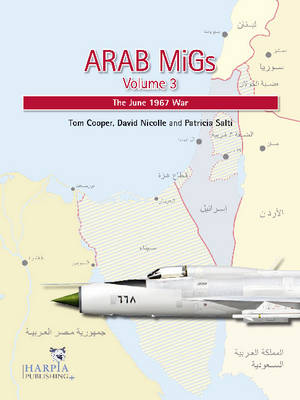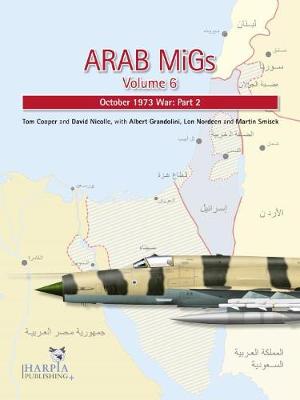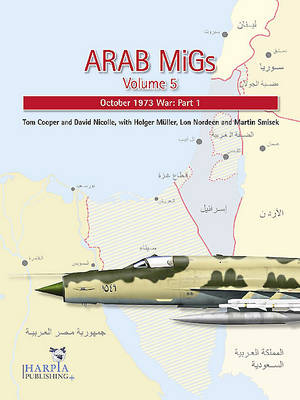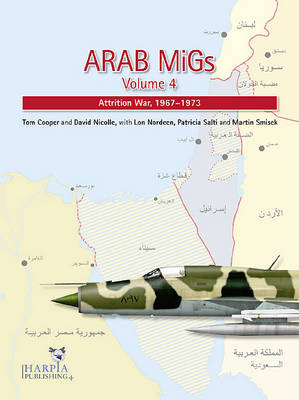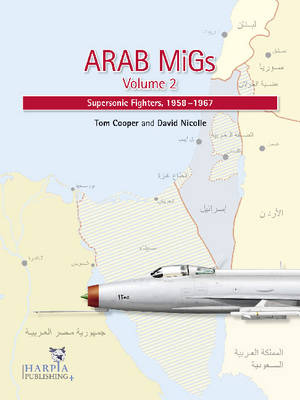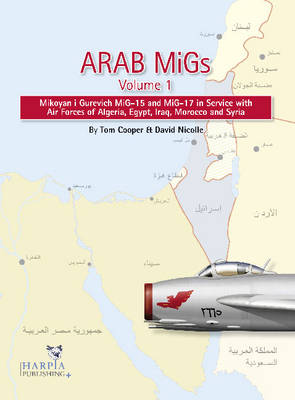Arab MiGs
6 total works
The June 1967 War fought between an Arab alliance and Israel was a pivotal event in the modern history of the Middle East. This study provides the most complete and detailed coverage ever of the Arab air forces during the course of that conflict. Supported by original documentation, and hundreds of blow-by-blow accounts from participants and eyewitnesses from Egypt, Iraq, Jordan and Syria, the result is a fascinating and gripping narrative that uncovers many new stories for the first time. Numerous vivid descriptions shed light upon Israeli attacks on Arab air bases, dozens of air combats, efforts to continue fighting against all odds, failures of Arab security and intelligence, and conflicts within the military chains of command. These stories are complemented by descriptions of the tactics and weaponry deployed.
Almost 350 photographs, diagrams and artworks combine with lucidly written text to produce one of the most informative and readable books on air warfare to have become available in recent years. Military historians and scholars interested in aviation and foreign affairs will find this volume of particular interest. As a unique work that presents the Arab point of view of a defining war, it stands as both a complement and a corrective to previous accounts of this much-misunderstood conflict.
Almost 350 photographs, diagrams and artworks combine with lucidly written text to produce one of the most informative and readable books on air warfare to have become available in recent years. Military historians and scholars interested in aviation and foreign affairs will find this volume of particular interest. As a unique work that presents the Arab point of view of a defining war, it stands as both a complement and a corrective to previous accounts of this much-misunderstood conflict.
Arab Migs Volume 6
by Tom Cooper, David Nicolle, Albert Grandolini, Lon O. Nordeen, and Martin Smisek
Published 19 November 2015
Arab MiGs Volume 6 continues Harpia Publishing’s renowned coverage of air actions by Arab air forces during the October 1973 Arab-Israeli War. After researching in the Middle East for more than 40 years, interviewing and discussing the fighting in detail with pilots, participants and eyewitnesses from almost every unit involved, the authors provide the first ever coherent narrative of this air war. While it has often been argued that air power did not play a dominant role in the conflict, it eventually proved critical to its outcome. Moreover, thousands of combat experiences that were learned during this war — and paid for in blood by both sides — proved extremely influential for the development of new aircraft types and new weapons systems. The October 1973 conflict was one of the best examples of the ever increasing importance of electronic warfare and unmanned aircraft upon the modern-day battlefield, and therefore prompted fundamental changes in the tactics and strategy of the dominant air powers across the globe during the late 20th century. As well as enabling the reader to gain a clear insight into the nature of the air operations by all involved air powers – and the Arab air forces in particular – and the weaponry deployed, this book contains a detailed cross-examination of claims from both sides, analyses aircraft losses on both sides and lays bare the over-claims, regardless of whether officially confirmed. Descriptions based on the reminiscences of veteran aircrews provide an unprecedented insider’s view of key aircraft and operations, illustrating how developments in technology and information warfare added a new dimension to the history of air warfare. Supported by a plethora of background information, more than 300 photographs, colour profiles, maps and diagrams depicting the action, aircraft, camouflage patterns, markings, and weaponry deployed, Arab MiGs Volume 6 is set to become the standard reference work on the subject.
On 6 October 1973, the Egyptian and Syrian air arms opened an Arab attack on Israeli military installations on the Sinai Peninsula and in the Golan Heights. Thus began a war for recovery of territories lost to Israel during the June 1967 War, but also a war that was intended to repair damaged military and national pride, and a war that was to bring Israel back to the negotiating table. For the Israelis, who grossly underrated the capabilities of their enemies, it was a war that started with a surprise and alarming losses in men and material, and was characterized by the deployment of advanced electronics, computers and guided missiles. For the Arabs it was a war of revenge, in the best traditions of ‘guts and glory’. During the first few days of the war, the Arab air arms supported Egyptian infantry that stormed through the Bar Lev Line and Syrian mechanized forces that pushed into the Golan plateau. Egyptian and Syrian air defense forces inflicted unprecedented attrition upon the Israeli Air Force, denying it the ability to exercise aerial dominance and thus preventing it from playing a decisive role in the conflict. Gradually, the Israelis recovered from the initial blows, and their air force began exerting considerable pressure upon Syria. Undeterred, and reinforced by the Iraqi Air Force, the Egyptians and Syrians continued to hit back, turning the war into another slugging match of attrition. Clearly written and illustrated with a rich and unique collection of exclusive photography and original illustrations, Arab MiGs Volume 5 provides a detailed record of aerial warfare during the opening phases of the October 1973 Arab-Israeli conflict. Drawing on extensive research, declassified information, and interviews with dozens of participants, it recounts the origins, operational history, and battle performance of all the air forces involved. While emphasizing the Arab point of view, Arab MiGs Volume 5 goes well beyond standard histories to offer suppressed information and a plethora of new insights, well away from the bias and distortions of both sides. As such, it is the first comprehensive analysis of the aerial operations waged by both sides in this conflict.
Volume 4 in Harpia Publishing's highly successful Arab MiGs series expands the history of the major Arab air forces that became involved in the wars with Israel during the period 1967 to 1973. It solves the intractable complexity of this violent period by dispassionately outlining the sequence of political and military events — in chronological and geographic order. The reader is systematically taken through Egyptian attempts to reconstruct its battered air force and expand its air defense capabilities, and then reestablish control of its airspace in spite of increasing and ever more aggressive Israeli attacks.
The military support Israel received from the United States not only resulted in both sides developing, testing and employing ever more advanced methods of air warfare, but eventually provoked a Soviet military intervention, which marked the culmination of the period better known as the War of Attrition.
The narrative continues with dramatic descriptions of the developments in Jordan, which culminated in a civil war in 1970, and with an exclusive insight into the previously unknown expansion of the Syrian air arm with extensive support from Czechoslovakia, in the late 1960s and early 1970s. The content is concluded with lesser known military events in Algeria, Morocco, Iraq and Libya, where a series of military coups resulted in developments that were to become critical not only for the future of the local air forces, but also well beyond the borders of those countries.
The military support Israel received from the United States not only resulted in both sides developing, testing and employing ever more advanced methods of air warfare, but eventually provoked a Soviet military intervention, which marked the culmination of the period better known as the War of Attrition.
The narrative continues with dramatic descriptions of the developments in Jordan, which culminated in a civil war in 1970, and with an exclusive insight into the previously unknown expansion of the Syrian air arm with extensive support from Czechoslovakia, in the late 1960s and early 1970s. The content is concluded with lesser known military events in Algeria, Morocco, Iraq and Libya, where a series of military coups resulted in developments that were to become critical not only for the future of the local air forces, but also well beyond the borders of those countries.
Largely based on original, previously unavailable documentation from official archives, as well as interviews with participants and eyewitnesses, the second volume in this series is an unprecedented study of the developments of the Egyptian, Iraqi, Syrian, Algerian, Lebanese and Jordanian air forces during the late 1950s and 1960s.
Not limiting themselves exclusively to the title of this series, the authors present the main topic– the introduction of supersonic fighters such as the MiG-19 and MiG-21 to service with these six air forces – against the geopolitical backdrop. For the first time, the authors explain how and why specific air forces developed in the way they did, why they received specific aircraft types, and also why they suffered a defeat with such dramatic consequences during the June 1967 War with Israel.
The volume is completed by an in-depth study of the application of early MiG-21 variants in combat, development of tactical combat methods in Syria during the mid-1960s, and finally an order of battle for the Egyptian Air Force as of 4 June 1967. The latter provides not only precise details of the number of specific aircraft available to each operational unit, but also EAF unit commanders, numbers of pilots, and even anti-aircraft units protecting specific air bases.
Not limiting themselves exclusively to the title of this series, the authors present the main topic– the introduction of supersonic fighters such as the MiG-19 and MiG-21 to service with these six air forces – against the geopolitical backdrop. For the first time, the authors explain how and why specific air forces developed in the way they did, why they received specific aircraft types, and also why they suffered a defeat with such dramatic consequences during the June 1967 War with Israel.
The volume is completed by an in-depth study of the application of early MiG-21 variants in combat, development of tactical combat methods in Syria during the mid-1960s, and finally an order of battle for the Egyptian Air Force as of 4 June 1967. The latter provides not only precise details of the number of specific aircraft available to each operational unit, but also EAF unit commanders, numbers of pilots, and even anti-aircraft units protecting specific air bases.
Starting in 1955, and for the following 20 years, MiG-15 and MiG-17 formed the backbone of several Arab air forces. They played a prominent role in four major wars and dozens of minor incidents.
Covering the first decade of this period, this study - Arab MiGs, Volume 1, the first in a series of publications - provides a unique and previously unavailable insight into the service history of both types with five Arab air forces. Even more so, it tells the story of people that flew MiG-15s and MiG-17s in Algeria, Egypt, Iraq and Syria. Several of whom became dominant political figures in most recent history of these countries.
The reason why Arab countries began purchasing MiGs and thus became embroiled in the Cold War is approached and discussed from an entirely new and original - Arab - point of view.
Details about combat operations during three major wars between Arabs and Israel, as well as the war in Yemen of the 1960s, are reconstructed on basis of primary evidence, foremost in form of original documents and participants' recollections.
Aircraft colors, unit insignia, serial- and construction numbers are described in an unprecedented detail.
Over 200 photos, color artworks, maps and tables illustrate the story of aircraft and their crews, but also many air combats that became highly influential for the future of aerial warfare and fates of several nations.
Covering the first decade of this period, this study - Arab MiGs, Volume 1, the first in a series of publications - provides a unique and previously unavailable insight into the service history of both types with five Arab air forces. Even more so, it tells the story of people that flew MiG-15s and MiG-17s in Algeria, Egypt, Iraq and Syria. Several of whom became dominant political figures in most recent history of these countries.
The reason why Arab countries began purchasing MiGs and thus became embroiled in the Cold War is approached and discussed from an entirely new and original - Arab - point of view.
Details about combat operations during three major wars between Arabs and Israel, as well as the war in Yemen of the 1960s, are reconstructed on basis of primary evidence, foremost in form of original documents and participants' recollections.
Aircraft colors, unit insignia, serial- and construction numbers are described in an unprecedented detail.
Over 200 photos, color artworks, maps and tables illustrate the story of aircraft and their crews, but also many air combats that became highly influential for the future of aerial warfare and fates of several nations.
